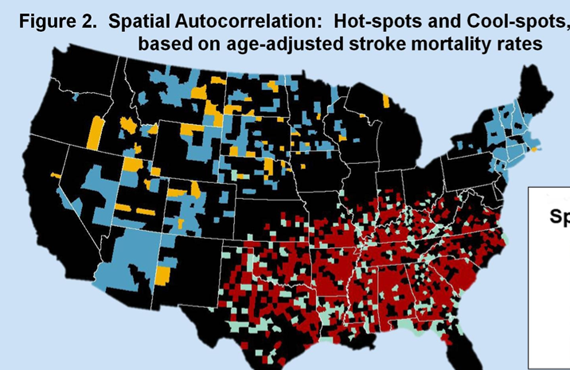Penn Medicine Stroke Experts Identify Geographic and Gender Disparities Among Stroke Patients, Demonstrate New App to Optimize Acute Stroke Care
Stroke researchers from the Perelman School of Medicine at the University of Pennsylvania will unveil a map demonstrating geographic hotspots of increased stroke mortality across the United States, among a series of stroke studies being presented at the American Academy of Neurology’s 66th Annual Meeting in Philadelphia, April 26 to May 3, 2014.
Hot and Cold: Stroke Mortality Varies Widely, Even in Neighboring Counties
Clusters of “hot” spots - counties where the mortality rate from stroke was as much as 40 percent higher than the national average and 1.5 times higher than mortality of patients in “cool” spots - were found in the southeastern United States, but extended farther west and north than the traditionally defined “stroke belt.” In addition, researchers found isolated areas of low stroke mortality clustered within hot spots and isolated areas of high stroke mortality clustered within cool spots. Researchers hope to identify hot-spots that would benefit from targeted interventions to increase access to optimal stroke care, while accounting for population density, demographics, and existing healthcare resources.
- Catherine Wolff and Michael Mullen, MD, assistant professor of Neurology, will present [P5.009] Geography of Stroke Mortality: Hotspotting Areas for Targeted Interventions on Wednesday, April 30, 2014 at 3:00 p.m., during P5: Poster Discussion: Cerebrovascular Disease and Interventional Neurology II from 3:00 pm - 6:30 pm in Hall E. The study was supported by NIH's Agency for Healthcare Research and Quality's (AHRQ) (grant R01 HS018362).
Women Less Likely To Receive Stroke-Busting rt-PA
In a second study examining at stroke treatment disparities, researchers identified that women are less likely to receive clot-busting recombinant tissue plasminogen activator (rt-PA) than men at both Primary Stroke Centers and non-Primary Stroke Centers, although the absolute difference was small. Prior studies have suggested that women receive lower quality stroke care, are less likely to receive acute stroke therapies, and are more likely to be disabled after stroke then men. Further research can investigate any differences in rt-PA eligibility, stroke severity, or time to presentation by sex.
- Dr. Mullen will present [P2.133] Gender Differences in Primary Stroke Center Evaluation and Utilization of rt-PA on Wednesday, April 30, 2014 at 3:00 p.m., during P5: Poster Discussion: Cerebrovascular Disease and Interventional Neurology II from 3:00 pm - 6:30 pm in Hall E. The study was supported by NIH's Agency for Healthcare Research and Quality's (AHRQ) (grant R01 HS018362).
Click here to view the full release.








